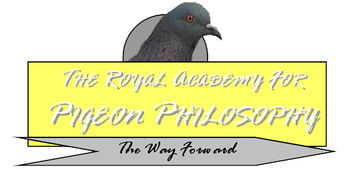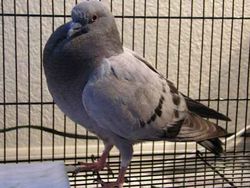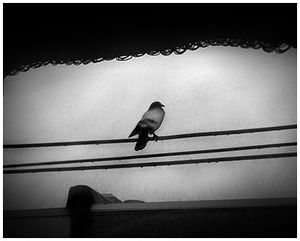Pigeon Philosophy
Pigeon Philosophy, or “Pigeon Studies”, is the immensely popular topic of analysing pigeons in deep and philosophical ways. The UK Government is particularly keen on the advancement of Pigeon Philosophy. In 2006 The Prime Minister stated that, due to the huge population of pigeons in the country, progress in the understanding of their very nature is key to the peaceful relationship between man and bird. Currently, 16% of all students at university are studying Pigeon Philosophy.
The vast majority of the knowledge we have today on Pigeon Philosophy derives from one man’s work – Professor P. Jon – who has helped considerably in pushing the envelope regarding the deeper meanings behind Pigeons. The rest of this article focuses on his studies.
Study 1 – Introduction to the Meanings of Pigeons[edit | edit source]
“I think that the hidden meanings behind pigeons are deep because they are, and because pigeons are metaphorical. The meanings behind pigeons are also deep because they are meaningful and significant and stuff. Philosophers like to study pigeons not only because they are very interesting, but also due to the fact that, I believe, pigeons are meaningful and have deep messages. Pigeons also carry meaningful messages on their legs that people put there because they do.
Methinks that, on the other hand, pigeons aren’t special. This is largely due to the fact, in part, because they are not special. Un-special pigeons fail to be special also because they are only special when they have special qualities that make them special, which does not make them especially special, especially when they’re specifically not special anyway, which is nothing special.
In conclusion, pigeons are meaningful but not special.”
Study 2 – Pigeons and Trees[edit | edit source]
“Further analysis suggests that pigeons, as well as being meaningful, and as well as not being special, also like trees. This is proven because they are often seen to like trees. This is good and encouraging. Trees are not violent to pigeons and are peaceful towards them, so pigeons like trees. People sometimes observe pigeons in trees, which is further proof that, when it comes to trees, pigeons like the comforts of trees and also like to be around trees in areas where there are lots of trees and other things that may resemble trees to some degree. Therefore trees are ultimately something pigeons like.”
Study 3 – Pigeons, and Fish & Chips[edit | edit source]
“It is common to see Pigeons in Urbanised areas. This is for one of two reasons:
a) They like Urban Music
b) They like Fish & Chips
The possibility of both options being true simultaneously is possibly impossible, as it is possibly impossibly impossible. After all, it is well known that Pigeons are tone-deaf whilst eating. This has already been proven by other sources, which are too obvious to state in this study. This rules out option (a) altogether because, looking at the wider context of the argument to such a large degree, it does.
Fish & Chips are purchased by urbanised humanoid dwellers, known as “Townfolk”. Townfolk naturally drop fish and chips onto the floor on a regular basis because they have butter fingers. This is true because I heard someone say so, and also because you believe me and I tell truths. Pigeons eat anything, and see anything as eatable. Therefore, we can establish that pigeons like to eat these butter fingers after they have finished their Fish & Chips, and this would lead to consistent and aggressive attacks on Human Beings. This is worrying because of anxious feelings, based on certain, upsetting fear, which is frightening and terrifying on a catastrophic scale. I will look, observe, view, analyse, scrutinize, inspect, study and examine this evil in greater detail, which in turn will further establish or calm the great fear in my bones…”
Study 4 - The Dove Hypothesis[edit | edit source]
"Study Four brings forth the following hypothesis – "Doves are White Pigeons". I can prove this hypothesis correct because of the My Analysis study, in which we come to understand that I am always right. This is because of my tendency to be 100% correct approximately 100% of the 100% of life I have lived. Of this I am 99.8% certain, but I am 100% certain that the 99.8% certainty may be 0.2% too low.
Doves are largely recognised as a symbol of peace. Pigeons, however, are not. Pigeons are not peaceful, they are noisy. Yet I have researched, via my research, which is fully researched and researchable, that Doves do in fact make noises similar to pigeons. Thus, this further proves Doves are nothing more than white pigeons. Also, doves think themselves better than pigeons because of their symbolic importance, even though their only difference is their colour. Hence, Doves are racist. From this day, to celebrate equality amongst pigeons, we shall hence forth call doves white pigeons. This new name shall imply no superiority of the Dove, over the pigeon."
Study 5 - Pigeons as Suspicious[edit | edit source]
"This study is mostly about my finding pigeons suspicious. This is because pigeons do very suspicious things. Indeed, their ability to be suspicious on many different levels is particularly suspicious, and hence my suspicion is heightened. I have grown wary of pigeons as a result, and their suspicious actions make me doubtful, apprehensive and mistrustful, as well as wary. Further, I find my suspicion suspicious, which is in itself suspicious. This is because I am suspicious the pigeons want me to feel suspicious, wary, and even more suspicious, which makes me suspiciously suspicious. I hence positively propose a pigeon perfectly plotted panic paranoid people plan (or P.P.P.P.P.P.P) is presently persisting. My suspicion in my suspicion of my suspicion being suspiciously suspicious is not only suspicious, but also my inklings and doubtful notions of feelings and thoughts also bring about a kind of nervous and anxious suspicion. This makes me feel uneasy, wary and unsafe. Thus, it is conclusive that pigeons are definitely, categorically, certainly, undeniably and unquestionably, beyond any doubt and without any doubt, quite probably suspicious. However, whether pigeons are in fact absolutely and unconditionally suspicious remains to be seen. I find the uncertainty particularly suspicious. I will continue to scrutinise pigeon activity in an optimistic but sceptical way with great focus."
Study 6 - Pigeons are not Pets[edit | edit source]
On May 21st 2007, Professor P. Jon was reportedly spotted drunk and disorderly at a nightclub. The members of the public described how the professor staggered up to the DJ of the club and knocked him unconscious with a novelty ‘pigeon hammer’, which he had taken from the inside pocket of his lab coat. The hammer was said to have emitted the sound of a pigeon’s coo on impact. At this point, one member of the now slightly panicked public recorded footage of the subsequent incidents. The footage shows the professor stopping the music and, taking the microphone in his right hand, whilst swaying slightly and waving the pigeon hammer in his left, started to rap. The next morning, a very hung-over Prof. P. Jon told the press that he regretted the night’s events, not least because the material he was rapping was in fact extremely confidential, and was not due to be released until later in the year. Nevertheless, he felt the rap artistically complimented his study, and declared it as his official 6th study, remaining in rap form, later in the week.
“It came to me quite clear
As I took a swig of beer
That pigeons are not pets
No, pigeons are not pets
They’re not because they’re not
And why? I’ll tell you what:
A pigeon you can’t pet
A pigeon you can’t pet
Watchin’ the TV set
A show about a vet
No pigeons were there there
No pigeons were there there (there there)
And so it seemed to me
That pigeons should be free
Don’t let the things near you
If you don’t want bird flu
To all you pigeon racers
I’m comin’ round to chase yers
To tell you they aint pets
No pigeons, they aint pets
Petal, pet a petting pet
‘Cos Pigeon petting’s pitiful
Don’t pat a pigeon pet
Don’t pat a pigeon pet
Yo yo!”
At this point, Prof P. Jon collapsed due to over consumption of alcohol. However the professor seems content that the message of his study was delivered fully and cohesively.
Study 7 - The Study of Pigeons[edit | edit source]
Taken from Prof P. Jon's latest book Pigeon Philosophy - Back to Basics:
"I feel that my studies of late have not attained the standards set by my earlier work, exemplified in particular by study 6. As a result, I have set myself two main aims:
a) Try and quit drinking (again)
b) Return to a more objective and academic approach to Pigeon Philosophy
In light of both points, I hereby present an abstract from my seventh piece of work – although not a study in quite the same sense as my previous papers, this work remains fundamental to Pigeon Philosophy. Its purpose is to propose the way one should approach pigeon philosophy itself, and how pigeons should correctly be studied.
The Science and Art of Studying Pigeons[edit | edit source]
1. Studying pigeons should be objective
I do not object to objections towards my lack of objectivity in Pigeon Philosophy in the past. Being objective was not my objective in previous work – I saw pigeons as objects subjected to subjective subjectivity. But in hindsight, pigeons are subjects too worthy of subjective analysis, and thus analytically should be analysed objectively and without objection. Under subjection to objection, I was subjected to setting my objectivity objective: that studying this subject subjectively subjects subjective subjection, and hence objective objectification is object.
2. Studying pigeons should be done quietly
Although I highlighted in study 4 that pigeons are not peaceful (indeed, they are noisy), studying pigeons should nevertheless be carried out quietly so as not to disturb them. Approaching a pigeon should be done by crawling, with one’s left leg raised slightly in the air. This makes you look like a pigeon a bit, because you appear to have a tail. Cooing twice occasionally may help the process, but under NO CIRCUMSTANCE should you coo thrice – doing so would offend the pigeon greatly. When you are approximately four metres from the pigeon, slowly take out your clipboard, pen and anything else you need. Attempting to solve the pigeon problem you have been given should be done promptly, in case the pigeon flies away.
Therefore, in order to pertain properly to pigeon practice procedures, pose peacefully and passively but purposefully. Pen down positive pigeon proofs passionately and promptly. Poking pigeons is poor practice and pointless – patient and persistent pensiveness prevails. Partaking in pigeon petting presents potentially perilous problems. Precaution proves prudent.
If you find it difficult to remember these instructions, making yourself an anagrammatic mnemonic may help."



